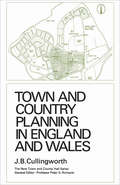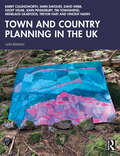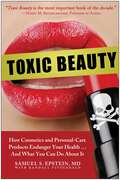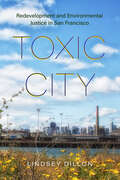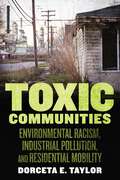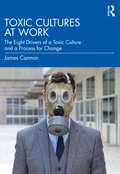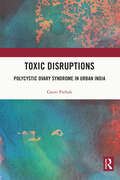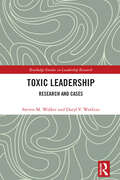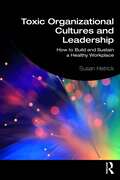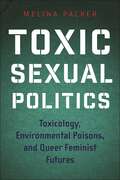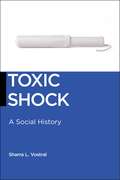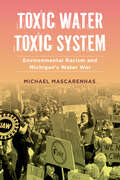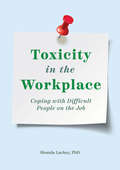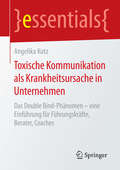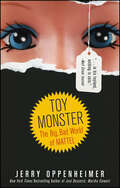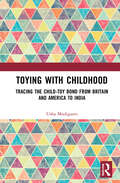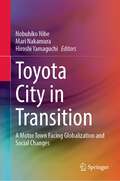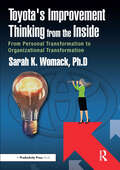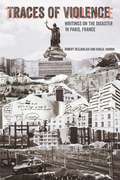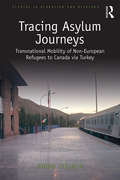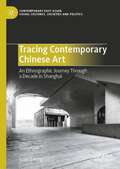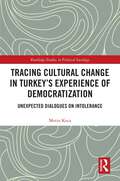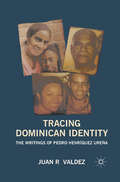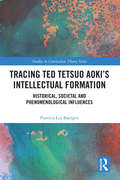- Table View
- List View
Town and Country Planning in England and Wales: The Changing Scene (The New Town and County Hall Series #8)
by J. B. CullingworthThe British Town and Country Planning machine is the most sophisticated in the world, yet its inadequacies are only too apparent to those who are familiar with its evolution and operation. During the last decade it has been in a constant state of change in an attempt to come to terms with the needs of a rapidly changing society. This work attempts to provide a comprehensive picture of the planning system and the ways in which it is changing. An historical introduction leads into an account of the machinery of planning and the major new provisions of the 1968 Town and Country Planning Act. Special attention is then paid to the problems of land values, amenity, derelict land, planning for leisure, new and expanding towns, urban renewal and the search for an adequate means of regional planning. The book ends with an examination of some of the fundamental problems of public acceptance of, and public participation in, a democratic system of planning. The book is aimed at the student and the general reader. It is not a legal text, but neither is it intended as a polemic.
Town and Country Planning in the UK
by Barry Cullingworth Simin Davoudi David Webb Geoff Vigar John Pendlebury Tim Townshend Menelaos Gkartzios Trevor Hart Vincent NadinTown and Country Planning in the UK provides one of the most authoritative and comprehensive accounts of British planning history, institutions, legislation, policies, processes and practices. This 16th edition has been substantially revised and re-organised to provide an up-to-date overview of the planning systems in the four nations of the UK, supported by analyses, interpretations, illustrations and examples from planning practice.The new edition features: details of the legislative and policy changes since 2015 and discussion of their implications, including the early stages of the Levelling Up and Regeneration Act, 2023 discussion of environmental policies and programmes and the impact of Brexit on environmental regulatory landscape in Britain changes to climate change and resilience policies, notably the government’s ‘Net Zero’ agenda and their implications for planning updates to the substantive issues in plan-making, especially the responses to the shortage of affordable housing and the development of major infrastructure changes to the processes involved in plan-making and development management an expanded and revised chapter on design to include the growing significance of public health in the built environment major revisions to the chapter on rural planning revisions of the text on planning theory especially in relation to management of conflicts over the use and development of land extended discussion of politics, professionalism and participation in planning The 16th edition of Town and Country Planning in the UK is an ideal starting point for those who are studying or working in the planning field, and for other professionals who need to locate their work in the planning context.
Toxic Beauty: How Cosmetics and Personal-Care Products Endanger Your Health... and What You Can Do About It
by Samuel S. EpsteinSplashy ads and commercials for personal care products are everywhere we turn, promising to keep our appearances fresh and our partners satisfied. But do consumers really know what they're applying to their faces and bodies in their quests for youth and beauty? Do they know the health risks they're taking by simply applying lipstick, face moisturizer or deodorant? Toxic cosmetics and personal care products clutter the shelves at retail stores everywhere, and consumers don't know the avoidable risks they're taking by following a simple beauty regimen. Written by Dr. Samuel S. Epstein, a founder and chairperson of the Cancer Prevention Coalition, Toxic Beauty gives the lowdown on salon safety, health risks hiding in everyday products, how we put our children in danger and more. Toxic Beauty will also educate you and your family on easily implemented solutions through the use of a variety of positive alternatives. Through the help of Dr. Epstein and Toxic Beauty, you can protect yourself from the possible long-term effects of a simple beauty product.
Toxic City: Redevelopment and Environmental Justice in San Francisco
by Lindsey DillonToxic City presents a novel critique of postindustrial green gentrification through a study of Bayview-Hunters Point, a historically Black neighborhood in San Francisco. As cities across the United States clean up and transform contaminated waterfronts and abandoned factories into inviting spaces of urban nature and green living, working-class residents—who previously lived with the effects of state abandonment, corporate divestment, and industrial pollution—are threatened with displacement at the very moment these neighborhoods are cleaned, greened, and revitalized. Lindsey Dillon details how residents of Bayview-Hunters Point have fought for years for toxic cleanup and urban redevelopment to be a reparative process and how their efforts are linked to long-standing struggles for Black community control and self-determination. She argues that environmental racism is part of a long history of harm linked to slavery and its afterlives and concludes that environmental justice can be conceived within a larger project of reparations.
Toxic Communities: Environmental Racism, Industrial Pollution, and Residential Mobility
by Dorceta TaylorUncovers the systemic problems that expose poor communities to environmental hazardsFrom St. Louis to New Orleans, from Baltimore to Oklahoma City, there are poor and minority neighborhoods so beset by pollution that just living in them can be hazardous to your health. Due to entrenched segregation, zoning ordinances that privilege wealthier communities, or because businesses have found the ‘paths of least resistance,’ there are many hazardous waste and toxic facilities in these communities, leading residents to experience health and wellness problems on top of the race and class discrimination most already experience. Taking stock of the recent environmental justice scholarship, Toxic Communities examines the connections among residential segregation, zoning, and exposure to environmental hazards. Renowned environmental sociologist Dorceta Taylor focuses on the locations of hazardous facilities in low-income and minority communities and shows how they have been dumped on, contaminated and exposed.Drawing on an array of historical and contemporary case studies from across the country, Taylor explores controversies over racially-motivated decisions in zoning laws, eminent domain, government regulation (or lack thereof), and urban renewal. She provides a comprehensive overview of the debate over whether or not there is alink between environmental transgressions and discrimination, drawing a clear picture of the state of the environmental justice field today and where it is going. In doing so, she introduces new concepts and theories for understanding environmental racism that will be essential for environmental justice scholars. A fascinating landmark study, Toxic Communities greatly contributes to the study of race, the environment, and space in the contemporary United States.
Toxic Cultures at Work: The Eight Drivers of a Toxic Culture and a Process for Change
by James CannonAround the world and across industries, toxic workplaces are in the news. Taking a holistic approach, this book gives a succinct summary of how toxic cultures develop and shows how they can be remedied with practical takeaways for organisations. Existing books on toxic culture either skim the surface of the latest scandal or take a theoretical approach of limited use to practitioners trying to improve their organisations. Now, organisational development expert James Cannon presents an all-in-one resource based on organisational and individual psychology research that offers actionable suggestions for required change. Cannon provides a framework to understand the complexities of a toxic culture, identifying eight drivers: power, leadership personalities, values, organisation design, formal and informal systems, relations with the external environment and individual systems of motivation and reward. The book also offers a comprehensive toolkit with questionnaires and checklists to manage and achieve cultural change. Professionals and students in organisational psychology, business, and change management, as well as those with an interest in the political and social issues raised by toxic cultures, will appreciate this guide on how to tackle a problem that is much discussed but seldom solved.
Toxic Disruptions: Polycystic Ovary Syndrome in Urban India
by Gauri S. PathakThis book provides a unique ethnographic account of women living with polycystic ovary syndrome (PCOS) in India. It examines how contaminated environments and political–economic changes render urban middle-class women in India vulnerable to PCOS, a condition which has the potential to disrupt conventional, normative feminine biographies of marriage and childbearing. The volume revolves around two main themes: how toxic landscapes, the endocrine disrupting chemicals suffusing them, and the political–economic environments related to them are linked to endocrine disorders such as PCOS; and how the biosocial disruptions caused by PCOS are both affecting women and reflective of changes in contemporary urban India. The author draws on anthropological fieldwork to investigate these connections through a fresh approach, combining a political ecological framework with perspectives from the anthropology of toxic exposures and health–environment systems. The first of its kind, this volume will be indispensable to students and researchers of anthropology, particularly medical anthropology, medical sociology, human geography, science and technology studies, medical humanities, health–environment systems, endocrine disorders, public health, and South Asian studies.
Toxic Leadership: Research and Cases (Routledge Studies in Leadership Research)
by Steven M. Walker Daryl WatkinsToxic Leadership: Research and Cases presents research and cases on toxic leadership that emerged from qualitative research on the followers of toxic leaders. The goal is to help students, researchers, and academics understand how toxic leadership emerges, how leaders can spot toxic leadership within their organizations, and discuss what they can do to stop toxic leaders from destroying organizational value. The book pulls together various theories, models, and names (e.g., bad leadership, destructive leadership) for toxic leadership. The authors cover how power, culture, personality disorders, and followers contribute to the toxic leadership phenomenon. Readers will learn how toxic leaders impact organizations, the types of toxic leaders, signs of toxic leaders, and the environments they create. The authors share case studies for each toxic leader type to illustrate themes, coping strategies, and organizational outcomes. Each case is accompanied by a series of questions for reflection, study, and leadership development. This book will be useful for students, researchers, and academics to help uncover signs of toxic leaders that are often hidden from upper management. It will also be helpful for leaders to develop organizational strategies and for followers to develop coping strategies.
Toxic Leadership: Research and Cases (Routledge Studies in Leadership Research)
by Steven M. Walker Daryl WatkinsToxic Leadership: Research and Cases presents research and cases on toxic leadership that emerged from qualitative research on the followers of toxic leaders. The goal is to help students, researchers, and academics understand how toxic leadership emerges, how leaders can spot toxic leadership within their organizations, and discuss what they can do to stop toxic leaders from destroying organizational value.The book pulls together various theories, models, and names (e.g., bad leadership, destructive leadership) for toxic leadership. The authors cover how power, culture, personality disorders, and followers contribute to the toxic leadership phenomenon. Readers will learn how toxic leaders impact organizations, the types of toxic leaders, signs of toxic leaders, and the environments they create. The authors share case studies for each toxic leader type to illustrate themes, coping strategies, and organizational outcomes. Each case is accompanied by a series of questions for reflection, study, and leadership development.This book will be useful for students, researchers, and academics to help uncover signs of toxic leaders that are often hidden from upper management. It will also be helpful for leaders to develop organizational strategies and for followers to develop coping strategies.
Toxic Organizational Cultures and Leadership: How to Build and Sustain a Healthy Workplace
by Susan HetrickToxic organizational cultures and leadership have led to major reputational failures, with the greatest impact felt by the people who dedicate their careers to working for these organizations. And yet organizations do not become toxic overnight. They do not consciously set out to break rules and regulations, nor do they actively seek wrongdoing. This book defines toxic culture, explains how toxic cultures emerge over time, and provides practical approaches supported by in-depth research for overcoming a toxic culture at the individual, team, and organizational level. Pragmatic and applicable, the book provides a call to action that can be applied in any type of organization. While the role of leadership in toxic cultures is acknowledged, the book sets out four distinct stages to embedding toxic cultures and draws on examples from leading organizations and companies to illustrate each stage. The book then identifies interventions and levers that can be implemented by executives, boards, and HR practitioners to prevent toxicity and to change toxic cultures back to healthy, positive workplaces. Drawing on research and interviews with senior HR leaders and executives, the book provides: An understanding of the four stages of toxic cultures and the impact of performance pressures in driving toxicity An appreciation of the role of senior leadership and personality traits Practical tools and guidance on interventions for practitioners to build and sustain a healthy and positive workplace Senior executives, HR, and organizational development practitioners in local and global organizations spanning a range of industry sectors will find this book invaluable. The book is also highly relevant to consultants working in the field of corporate culture and change.
Toxic Sexual Politics: Toxicology, Environmental Poisons, and Queer Feminist Futures (Health, Society, and Inequality)
by Melina PackerA bold exposé of how the very foundation of toxicology has been contaminated by sexist and racist ideologiesThe first critical understanding of the field of toxicology from a feminist and antiracist perspective, Toxic Sexual Politics asserts that the science of toxicants must be held accountable for the uneven distribution of toxic pollution along racial and sexual lines. Drawing upon in-depth interviews and extensive ethnographic and archival research, including participant observations in toxicology classrooms, conferences, and laboratories, Melina Packer urges environmental health advocates to place toxicant science within its masculinist, militarist, and eugenicist history.Toxic Sexual Politics shows how the founding fathers of U.S. toxicology were ideologically aligned with the chemical industry, inventing a science that could “make chemicals safe,” as opposed to one that could adequately protect planetary health from toxicants’ hazards. While many toxicologists today are critical of the chemical industry, they continue to rely on the highly limited tools of toxicology as accurate measures of toxicity, as do government regulators, the courts, and environmental advocates.Unlike most critiques of the chemical industry and narratives of environmental health movements, Toxic Sexual Politics refuses to take the science at face value. By focusing on the sexist, racist, and ableist biases reinforced by toxicology, Packer powerfully argues that this scientific discipline reproduces the very same white supremacist and heterosexist logics that generated environmental injustices in the first place. The field of toxicology can explicitly confront chemical corporate power by building from queer, feminist, anti-ableist, and antiracist movements for environmental and reproductive justice.
Toxic Shock: A Social History (Biopolitics #6)
by Sharra L. VostralA history of Toxic Shock Syndrome In 1978, doctors in Denver, Colorado observed several healthy children who suddenly and mysteriously developed a serious, life-threatening illness with no visible source. Their condition, which doctors dubbed ‘toxic shock syndrome’ (TSS) was rare, but observed with increasing frequency over the next few years in young women, and was soon learned to be associated with a bacterium and the use of high-absorbency tampons that had only recently gone on the market. In 1980, the Centers for Disease Control identified Rely tampons, produced by Procter & Gamble, as having the greatest association with TSS over every other tampon, and the company withdrew them from the market. To this day, however, women are frequently warned about contracting TSS through tampon use, even though very few cases are diagnosed each year. Historian Sharra Vostral’s Toxic Shock is the first and definitive history of TSS. Vostral shows how commercial interests negatively affected women’s health outcomes; the insufficient testing of the first super-absorbency tampon; how TSS became a ‘women’s disease,’ for which women must constantly monitor their own bodies. Further, Vostral discusses the awkward, veiled and vague ways public health officials and the media discussed the risks of contracting TSS through tampon use because of social taboos around discussing menstruation, and how this has hampered regulatory actions and health communication around TSS, tampon use, and product safety. A study at the intersection of public health and social history, Toxic Shock brings to light the complexities behind a stigmatized and under-discussed issue in women’s reproductive health. Importantly, Vostral warns that as we move forward with more and more joint replacements, implants, and internal medical devices, we must understand the relationship of technology to bacteria and recognize that both can be active agents within the human body. In other words, unexpected consequences and risks of bacteria and technology interacting with each other remain.
Toxic Water, Toxic System: Environmental Racism and Michigan's Water War
by Prof. Michael MascarenhasThe tireless resistance of local communities fighting for ownership of America’s third largest water system Toxic Water, Toxic System exposes the consequences of a seemingly anonymous authoritarian state willing to maintain white supremacy at any cost—including poisoning an entire city and shutting off water to thousands of people. Weaving together narratives of frontline activists along with archival data, Michael Mascarenhas provides a powerful exploration of the political alliances and bureaucratic mechanisms that uphold inequality. Drawing from three years of ethnographic fieldwork in Flint and Detroit, this book amplifies the voices of marginalized communities, particularly African American women, whose perspectives and labor have been consistently overlooked. Toxic Water, Toxic System offers a fresh perspective on the ties between urban austerity policies, environmental harm, and the advancement of white supremacist agendas in predominantly Black and brown cities.
Toxicity in the Workplace: Coping with Difficult People on the Job
by Shonda Lackey PhDNavigating a toxic work environment—a guide to managing difficult colleagues and stressful situations There are everyday challenging work relationships, and then there are situations that go beyond the ordinary—situations that push you to the edge. Written by a clinical psychologist who is knowledgeable about the mental disorders that can cause toxic behavior, Toxicity in the Workplace will help you understand why your difficult colleagues act the way they do and gain practical strategies for negotiating more peaceful, productive solutions. Armed with new insight into your colleagues' behaviors, you will learn pragmatic techniques that will give you the confidence to advocate for yourself and, when needed, remove yourself from uncomfortable situations and conversations. This book about dealing with toxic behavior in the workplace includes: Techniques for everyone—Learn approaches for communication with toxic people at all levels within an organization that are tailored to various problematic behaviors. Understand deeper motivations—Common anxiety, mood, and personality disorders are explained. Learn by example—Vivid case studies illustrate familiar scenes at work and model how you can respond respectfully and assertively. When you're looking for a book about how best to deal with difficult people at work, look no further than Toxicity in the Workplace.
Toxische Kommunikation als Krankheitsursache in Unternehmen: Das Double Bind-Phänomen – eine Einführung für Führungskräfte, Berater, Coaches (essentials)
by Angelika KutzIn diesem essential untersucht Angelika Kutz die Selbstwert-Vernichtungsmaschinerie des toxischen Kommunikations-Musters ,,Double Bind" als mögliche Ursache der meisten psychisch bzw. psychosomatisch bedingten Ausfälle in Unternehmen sowie hilfreiche Gegenmaßnahmen. Ziel der Autorin ist es, die krankheitsfördernden Kommunikations-Strukturen des Double Binds transparent zu machen. Dies dient der Entlastung von Betroffenen und Führungskräften sowie der Unterstützung für Coaches im Beratungskontext, da krankheitsbedingte Fehlzeiten aufgrund psychischer Erkrankungen heute kontinuierlich zunehmen.
Toy Monster: The Big, Bad World of Mattel
by Jerry OppenheimerAn eye-popping, unauthorized exposé of the House of Barbie from the New York Times–bestselling author of The Kardashians and Crazy Rich. From Boise to Beijing, Mattel&’s toys dominate the universe. Its no fun-and-games marketing muscle reaches some 140 countries, and its iconic products have been a part of our culture for generations. Now, in this intriguing and entertaining exposé, New York Times–bestselling author Jerry Oppenheimer places the world&’s largest toy company under a journalistic microscope, uncovering the dark side of toy land, and exploring Mattel&’s oddball corporate culture and eccentric, often bizarre, cast of characters. Based on exclusive interviews and an exhaustive review of public and private records, Toy Monster exposes Mattel&’s take-no-prisoners, shark-infested corporate style. Throughout this scrupulously reported, unauthorized portrait, you&’ll discover how dangerous toys are actually nothing new to Mattel, and why its fearsomely litigious approach within the brutal toy business has helped their products dominate potential rivals such as Bratz. Engaging and accessible, Toy Monster shows you why today&’s toy business isn&’t always fun and games. &“Oppenheimer . . . has now trained his sights on the world&’s biggest toy company—its egos, scandals and flawed products. In his toyland, nothing is cute.&” —The Wall Street Journal &“Oppenheimer takes a tour of Mattel&’s seamier side, highlighting its dubious corporate practices and kooky cast in this scathing portrait . . . Fast-paced and engaging, this exposé will absorb readers until the last page and will forever change the way they think about the company.&” —Publishers Weekly &“Thoroughly researched, beautifully written, Oppenheimer&’s opus contains all the intrigue and drama of an epic novel.&” —C. David Heymann, New York Times–bestselling author
Toying with Childhood: Tracing the Child-Toy Bond from Britain and America to India
by Usha MudigantiThis book studies the dialectic relationship between the image of the child and the toy in literary depictions of childhood in 19th- and 20th- century Anglo-American fiction. Drawing from the psychoanalytic theories of Sigmund Freud, Anna Freud, D.W. Winnicott, and Sudhir Kakar, it analyses themes such as the heterogeneity of childhood and the construction of the ideals of childhood. It explores the linkages between the ideals of childhood in Britain and its travel to America and further dissemination in British India. It discusses the established tropes of childhood such as innocence, a formative period, the centrality of play, and the presence of a toy to argue that the mores of childhood are culturally constructed and lead to the reification of a child into an image of perfection. The author problematises the notion of essential innocence and discusses the repercussions of such stereotypes about childhood. The work also highlights parallels between the ideals of childhood established in 19th-century Britain and the portrayals of postcolonial Indian childhoods in 20th-century Indian English literature. Toying with Childhood will be useful for students and researchers of education, childhood studies, psychology, sociology, literature, gender studies, and development studies. It will also appeal to general readers interested in cultural perceptions of childhood, literary depictions of children, and the works of Sigmund Freud.
Toyota City in Transition: A Motor Town Facing Globalization and Social Changes
by Hiroshi Yamaguchi Nobuhiko Nibe Mari NakamuraThis informative monograph focuses on the city of Toyota, located in Aichi Prefecture, Japan. Aside from the fact that most Toyota passenger vehicles are produced there, generally little is known about its reality.Since the 1960s, the city has continuously attracted numerous jobseekers from distant rural areas. Owing to years of stable employment and settlement within local communities, once-new workers gradually build strong ties with their neighbours and actively participate in residential activities. This pattern of settlement provides a unique example of long-prosperous industrial cities, which deserves discussion against a backdrop of the present “de-industrializing” urban economies.Unfortunately, this favourable situation is now changing, despite the regional economy’s steady recovery from the 2008 financial crisis. Addressing this paradox is the main focus of the present book. The upgrading of the Toyota Production System and concomitant widening class disparity are damaging local ties under severe pressure from global competition. Other suppressing factors are driven by sociological conditions, such as aging, declining marriage rates and birth rates. By comparing two sets of survey data, from 2009 and 2015, and performing fieldwork research in two communities that once were “new towns”, the book seeks to provide an understanding of the present situation of this unusual industrial city. At the same time, a unique theoretical perspective is revealed that does not fit the mould of either the Chicago School or the new urban sociology.
Toyota's Improvement Thinking from the Inside: From Personal Transformation to Organizational Transformation
by Sarah K. WomackThis book helps close the gap in how organizations think about and implement Toyota’s continuous improvement methods and management system. The Toyota Production System (TPS) is often viewed and adopted in organizations as a collection of tools to remove waste and streamline processes to provide products or services faster, better, or cheaper. While the tools for improvement and management routines are important, they are not where the true power of the system lies. The author’s eight-year journey inside Toyota was full of experiences that developed the power for continuous improvement. These learnings are rarely if ever captured in books on lean or taught in business and engineering classrooms.This book describes, in part, how Toyota, through its coaches and leaders, develops its members’ capabilities through a series of continuous improvement (kaizen and problem-solving) activities. For many members of Toyota, this process results in a personal transformation that ultimately leads to organizational transformation.This book presents a model for organizational transformation that includes technical systems, organizational principles/values, and spirituality/mindset to achieve enduring high performance. This book shifts from the continuous improvement development way at Toyota to case studies illustrating the thinking and mindset to other organizations on their journey to transformation. It uses the TPS tools as an entry point for development and highlights the role that organizational values play in the pace of transformation. Several case studies are presented that include manufacturing (performance improvement of a production line), healthcare (improvement in neurosurgery patient flow), and education (improvement in standardized test scores).The key benefit of this book is that it provides insights into Toyota’s culture and improvement thinking to help other organizations reach enduring high performance. The book is written for a wide audience so that readers outside of manufacturing organizations can understand the broad applicability of the Toyota way. In addition, it is written succinctly to help readers and practitioners focus their transformation efforts.Sarah K. Womack is a distinguished researcher and consultant in the field of Industrial Engineering. Her Ph.D. in the department of Industrial & Operations Engineering from the University of Michigan, Ann Arbor focused on the intersection of lean manufacturing practices and ergonomics. She has published peer-reviewed articles, presented as guest speaker at conferences and universities, and facilitated copious workshops on lean manufacturing. She has established herself as a leading scholar and consultant of one of the world’s most coveted management systems, the Toyota Production System. She spent eight years on a journey in various leadership roles of "learning by doing" under some of the world’s greatest lean thinkers at Toyota. Applying Toyota’s management thinking, she consults across an array of industries with an innovative and practical approach to continuous improvement, organizational transformation, and operational excellence - coaching at every level from the C-suite to the shopfloor. She continues to learn and collect a patchwork of stories to teach and inspire others on their operational excellence journeys. In addition to her writing, consulting, and speaking engagements, Sarah is passionate about traveling the world and immersing herself in diverse cultures.
Traces of Violence: Writings on the Disaster in Paris, France
by Prof. Robert R. DesjarlaisIn this highly original work, Robert Desjarlais and Khalil Habrih present a dialogic account of the lingering effects of the terroristic attacks that occurred in Paris in November 2015. Situating the events within broader histories of state violence in metropolitan France and its colonial geographies, the authors interweave narrative accounts and photographs to explore a range of related phenomena: governmental and journalistic discourses on terrorism, the political work of archives, police and military apparatuses of control and anti-terror deterrence, the histories of wounds, and the haunting reverberations of violence in a plurality of lives and deaths. Traces of Violence is a moving work that aids our understanding of the afterlife of violence and offers an innovative example of collaborative writing across anthropology and sociology.
Tracing Asylum Journeys: Transnational Mobility of Non-European Refugees to Canada via Turkey (Studies in Migration and Diaspora)
by Ugur YildizThis book explores the asylum journey of non-European asylum applicants who seek asylum in Turkey before resettling in Canada with the aid of the Canadian government’s assisted resettlement programme. Based on ethnographic research among Syrian, Afghan, Eritrean, Ethiopian, Iraqi, Iranian, Somali, Sudanese and Congolese nationals it considers the interactions of asylum seekers with both UNHCR’s refugee status determination and Canada’s refugee resettlement programme. With attention to the practices of migrants, the author shows how the asylum journey contains both mobility and stasis and constitutes a micro-political image of the fluidity and relativity of attributed identities and labels on the part of state migration systems. A multi-sited ethnography that shows how the migration journey is linked to the production and reproduction of knowledge, as well as the diffusion of produced knowledge among past, present, and future asylum seekers who form trans-local social networks in the course of their route, in Turkey, and in Canada. Tracing Asylum Journeys will appeal to sociologists and political scientists with interests in migration and transnational studies, and refugee and asylum settlement.
Tracing Contemporary Chinese Art: An Ethnographic Journey Through a Decade in Shanghai (Contemporary East Asian Visual Cultures, Societies and Politics)
by Isaac LeungThis book explores the author's ten-year ethnographic journey in different locations in Shanghai. His immersion in China’s art world is grounded in a topology of places and new ways of writing and deploying history today. The ethnographic approaches to experiencing, analysing and representing space offer a critical tool to explore a different version of realism invisible in the nominal art and art history paradigms. As the market and institutional norms are still being defined, this book also documents and analyses how individuals have strived to negotiate boundaries in the art world and thus create unique selfhood. Instead of conventional methods of periodisation and stylistic analysis, this book presents a historiographic strategy emphasising the philosophical significance of spatial realism to offer insights into history, subjectivities and political institutions.
Tracing Cultural Change in Turkey's Experience of Democratization: Unexpected Dialogues on Intolerance (Routledge Studies in Political Sociology)
by Metin KocaDoes democracy require an agreement on specific foundational values? Bringing insights from Turkey to the study of democratization, this book argues that democracy may rather be about acknowledging the disagreement over values before negotiating over other concerns, such as rights, freedoms, capabilities and duties. It explores this idea by examining three landscapes of culture in Turkey, which have been the subjects of persistent stories regarding the unequal relationship between the self and the other. These include LGBT visibility and the entertainment sector, women and clothing, and Alevism and funerals. Through these case studies, the book analyses the remaking of (in)tolerance through the integration of LGBT representations into broader political struggles over values, the assertion of women’s rights and freedoms from traditional values surrounding dress, and the conflict between essentialist intolerance and the syncretic traditions of Alevi identity. Bringing these landscapes together with the surrounding cultural tensions in Turkey and the West, Tracing Cultural Change in Turkey's Experience of Democratization will be a valuable resource for students and scholars of Middle Eastern studies and politics, gender studies and cultural studies.
Tracing Dominican Identity
by Juan R. ValdezThe author analyzes and discusses the socio-historical meanings and implications of Pedro Henríquez Ureña's (1884-1946) writings on language. This important twentieth century Latin American intellectual is an unavoidable reference in Hispanic Linguistics and Cultural Studies.
Tracing Ted Tetsuo Aoki’s Intellectual Formation: Historical, Societal, and Phenomenological Influences (Studies in Curriculum Theory Series)
by Patricia Liu BaergenThrough careful examination of Ted Aoki’s life and work within its historical, societal and intellectual context, this text advances a new appreciation of the national distinctiveness of Canadian curriculum studies. The book draws unique comparison between Aoki’s writings and Heidegger’s concept of "being-in-the-world." In exploring Aoki’s narratives on momentous life events, the author attends to the interwoven, dynamic and poetic essence of the scholar’s intellectual formation and identifies a critically reflective style of theorizing. By contextualizing Aoki’s narrations on his momentous life events, the text engages with Aoki’s critical reflective and unique style of theorizing and foregrounds the prominent influence of Heidegger’s phenomenology and writings on Aoki’s thinking. A major contribution to understanding Aoki’s curriculum scholarship, this book is an important resource for researchers and post-graduate students working across curriculum studies discourse.
